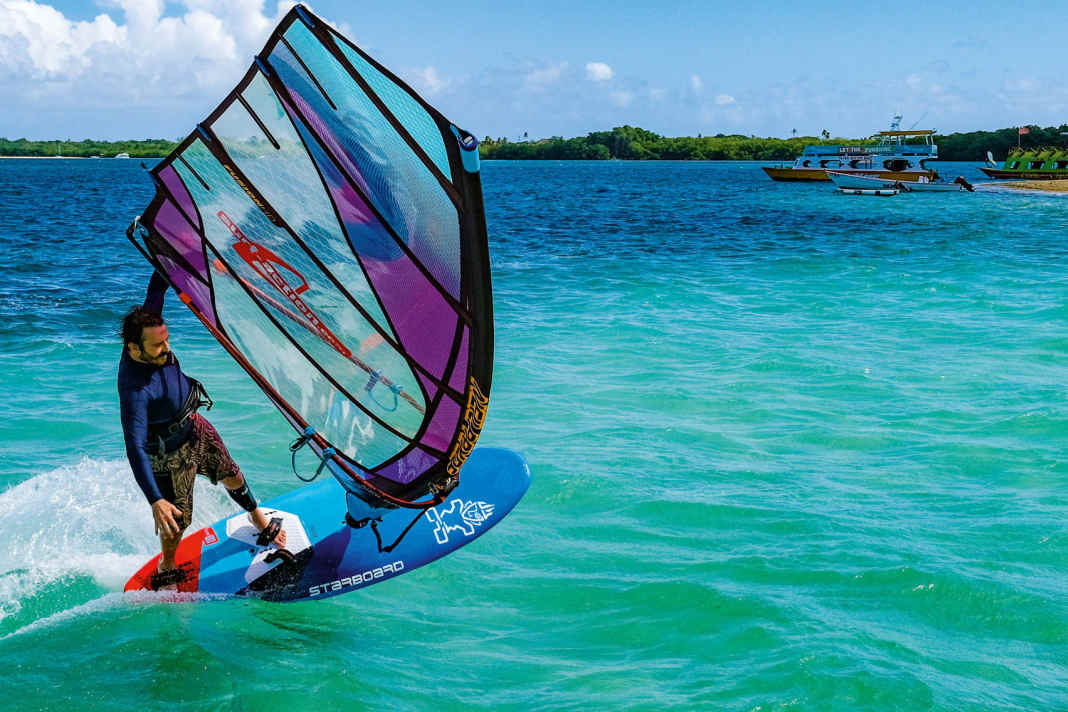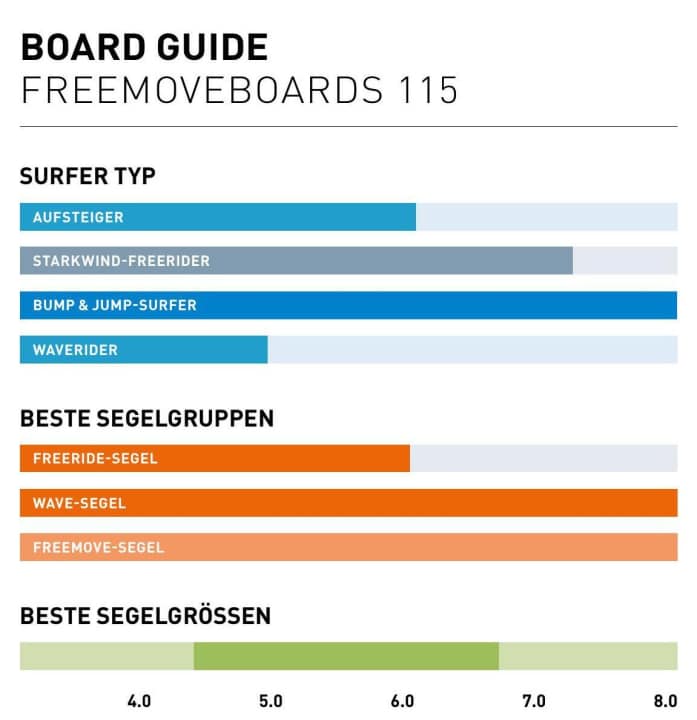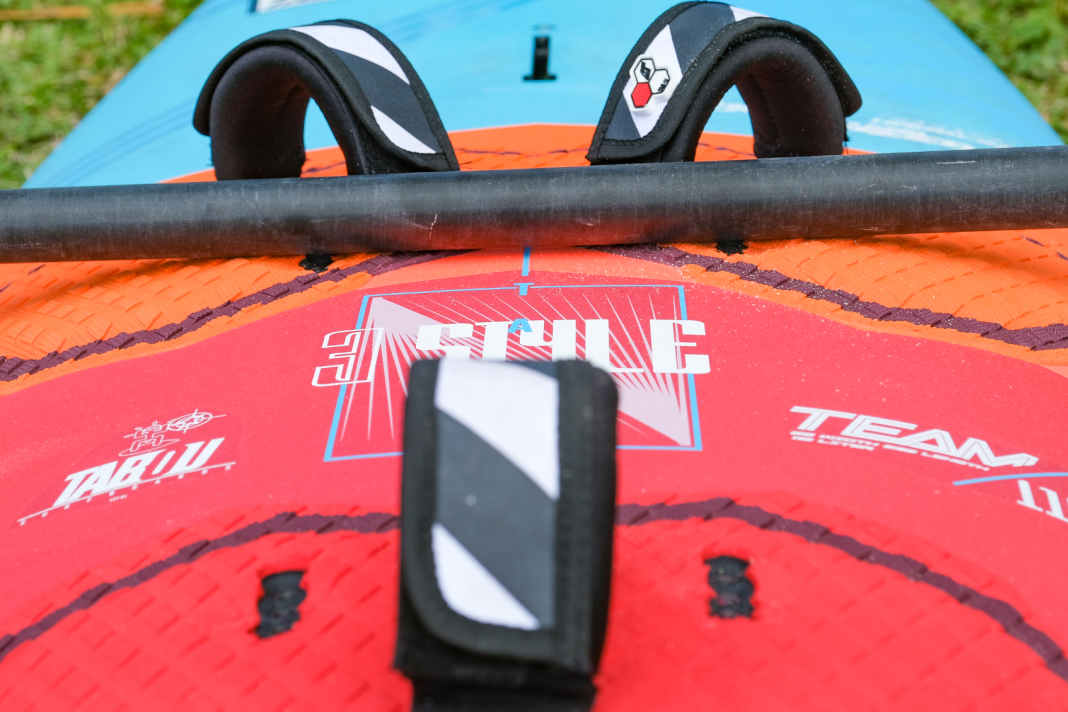





In this article:
These freemoveboards are included in the test:
(Click to go to the individual rating)
According to our idea, freemove is the freedom to surf with a board or sail in a wide variety of conditions and to have fun in choppy water, on flat slopes or in waves. No board is likely to come close to the wave or freeride specialists, but will score the most points overall. The 115 litre size tested here is well suited for sails from four and a half to just under seven square metres and therefore covers a particularly wide - and for many windsurfers also the most important - wind range.
115 litres with a 4.5 litre sail, some will ask critically, doesn't such a recommendation follow a bit of a marketing track? If you have a 115-litre freerider in mind, you are probably right. However, the explanation as to why these freemove boards still work well even with quite small sails lies in the shape and the fin configuration of the boards: V in the underwater hull, additional concaves and, above all, the configuration with three (shorter) fins allows the boards to run smoothly even in strong winds - without the tendency to "fly away" with the bow upwards in gusts. A lot of volume doesn't always hurt - especially if you don't feel it interfering with planing and manoeuvres.
Boards for intermediates and heavyweights
At around 115 litres, intermediates up to around 65 kilos who can already loop surf and are now aiming for the power jibe have enough buoyancy under their feet with these boards for a safe sheet start and a base for their first attempts at jibing that goes into the jibe willingly and without too much pressure. Lighter than some wide freeride boards that have been optimised for planing and heavier surfers.
"Every family man will find a strong wind board here that the children can also use." - surf tester Christian Winderlich, Norderney surf school
With a volume of 115 litres, however, wave use is naturally somewhat limited. Based on the formula that good wave surfers choose a board volume of around five to eight litres more than their body weight for riding waves in moderate or large surf, you have to weigh a fair amount for this board group with an average volume of 115 litres. However, a good 100 kilos is not a one-in-a-million exception. For surfers over the 100 litre mark, this group offers volume, planing potential and turning qualities.
Freemoveboards with plenty of wave potential
But in small to medium waves and in light winds, these boards invite you to play in the waves even with "only" 70 to 80 kilos on your ribs. This is because the boards can handle much larger sails than an 85-litre wave board - six and a half square metres are no problem at all - and suddenly you can bob out through the surf or to the reef further out with ease.
The boards hold their speed well in leisurely turns - which is often the key to the first cut back for wave beginners - which can only be achieved with enough speed at the lip of the wave. Wave beginners who are not already very proficient on smaller boards in flat water should therefore attempt their first attempts in the waves with a little more volume. During the first wave excursions, there will be plenty of new disruptive factors anyway - surfing a smaller board on top of that makes initial progress unnecessarily difficult.
However, these boards have their greatest strength as an all-in-one board. One board for all sails, for the most important wind range. Or as one board for the whole family. If you want to organise your windsurfing equipment as cheaply and space-savingly as possible, you can also go a long way with such a board and three sails. A typical range for a 90-kilo surfer would be the 115 board with sails in 4.7, 5.6 and 6.8. A light person weighing 60 kilos would also cover a wind range of four to almost seven wind forces with the shape-like 100 model and sails from 4.2 to 5.0 to 6.0.
"One board, three sails - that's enough for 80 per cent of all conditions." - surf tester Frank Lewisch

Features and details of the Freemoveboards 115






Shapes
When compared with other board groups in this volume class (freeride and freerace), the first thing that stands out is the smaller width compared to the volume. With a volume of 115 litres, freeride boards usually have a width of around 70 centimetres. In this group, however, the typical width is only around 65 to 66 centimetres. Freeride boards therefore benefit from greater tipping stability and more gliding performance. These freemoveboards, on the other hand, are easier to turn, appear more agile and therefore offer lighter surfers in particular enough volume to catch up with the sail, but are also easier and tighter to turn - without having to put as much weight on the edge as with a wide freeride board.
Finns
The fin equipment is also one size smaller than comparable freeride boards. The boards in this test with single fins are equipped with 30 to 36 cm fins. A freeride shape with the same volume - but with more width - is typically delivered with fins between 36 and 38 centimetres. Longer fins can improve glide, while smaller fins are always easier to turn. However, most of the models in this test field even come with three fins as standard (thruster set-up). This further increases the ease of turning (Starboard has the shortest centre fin at 22 centimetres) and often also improves control in the medium speed range. The thruster set is the first choice, especially for tight jibes and excursions into the waves.
In choppy water and with medium-wide power jibes, the longer solo fin is not a disadvantage, it can even give the board more stability and planing potential in the turn. All thruster boards (except Starboard) are equipped with a power box in the centre and can therefore be retrofitted with a single fin. The two outer boxes are then closed with matching blanking plugs, which are usually supplied with the boards. Conversely, boards such as the Fanatic Freewave can also be converted from a single fin to a thruster - however, this then requires three new fins, which rings a different bell at the till than with just one. When it comes to thruster sets, JP and RRD are out of the ordinary. At 29 centimetres, JP's centre fin is already longer (and wider) than average, while RRD takes it to the extreme with a 30 cm centre fin plus side fins. Patrik and Tabou 3S Classic, on the other hand, do without any boxes for optional side fins - which may also contribute to the extremely light weight of the 3S Classic. And at seven kilos, the Patrik board is also lighter than all thruster shapes.
Stand position and loops
Another noticeable feature of most boards is the very rounded deck shape in the rear area. This allows for a comfortable angle in the ankle even when the straps are mounted on the inside. Starboard and Severne emphasise this particularly strongly, with RRD this rounding is somewhat less pronounced.
The concepts also differ in the arrangement of the rear double loop - all offer a perforated strip for the single loop in the centre. A moderate position predominates, where the double loops are still far enough away from the rail to slip in easily. In comparison, you will find very performance-orientated positions very close to the rail on freeride boards of this size. The positions on Exocet, Patrik and both Tabou boards are a shade in this sportier freeride direction - but still moderate and not too extreme. At RRD, the two straps at the tail are so close together that there is only a slight difference to the single strap and the distance to the rail is slightly greater than usual. The testers found the most comfortable stance on the Starboard Kode, where the straps, shape and rounded deck shape complement each other to create a secure soft binding. With the RRD, on the other hand, some testers were bothered by the slightly harder edge of the foot pads if you stand right there with your heel.
On the water - play without limits
Climb on, slip into the loops - and glide off. And then see what works. That's exactly how we approached the test. With the option of small waves on the house reef at Pigeon Point in Tobago, sometimes moderate, sometimes stronger choppy waves in the large lagoon, just like at many home spots. And freestyle moves always work somehow anyway. With the exception of Patrik and Tabou Classic, these boards are not quite as fast as pure freeriders, but offer maximum playful potential with a good gliding wind. Power jibes, carving jibes, duck jibes, jumps, even loops and slid freestyle moves are possible. Then a hit to the house reef and a few turns in front of the moderately approaching wave - this also works surprisingly well. The testers assessed three different areas of use.
The recommended areas of use for the Freemoveboards 115
For all boards, you will find the suitability for three different areas of use. And this is perhaps the far more important currency than the individual scores, which work out the finer points for jibing, planing and speed.
- ForAscender a board should plane easily and tilt-stably, go through the jibe stably and not react too snappily to load errors.
- The typicalFreerider is primarily looking for a sporty riding experience, wants to let the board "fly" on the fin - and then glide quickly through the jibe. If the board reacts a little more sensitively - the freerider already has enough board feel for this. The main thing is that it goes through the turn with plenty of speed and then accelerates again quickly.
- ForFreestylewave the manoeuvring batten is raised. Tight turning is on the programme - in front of the wave and also at the end of the jibe for 360s, for example. The board should also jump well and be at least suitable for sliding manoeuvres.
Surf type recommendation for the right freemoveboard
If you are undecided, you will find a preliminary sorting here. However, we also recommend studying the corresponding board descriptions.
- Family boardsThis is where the all-rounders are needed. Boards with no weaknesses that allow you to experience waves for the first time, but also help you learn the power jibe. Exocet, Fanatic, JP-Australia, RRD and Starboard have shapes in this league that show no real weaknesses in any discipline and thus follow the wide-ranging freemove concept in all directions.
- Theadvanced windsurferThe Fanatic Freewave, JP Freestylewave, Starboard Kode, Severne Dyno and Tabou 3S+ are the obvious choice for the next step, which focuses on waves and manoeuvres.
- Who asAscender If you are looking for a board for the fastest possible learning progress in medium winds, you will probably learn particularly quickly on Exocet, Fanatic, JP, Starboard and Tabou Classic.
- ForInland water surfersFor those looking for a board for freeride and bump & jump, the Exocet and Patrik offer plenty of performance with an equally wide wind range.
Strengths and weaknesses of freemoveboards






All Freemoveboards in the individual evaluation
Click here for the detailed test results of all Freemoveboards:

